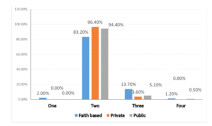Prescribing Patterns of Antihypertensives and Antidiabetics in Public and Private Healthcare Centres in North Central Nigeria
https://doi.org/10.51412/psnnjp.2022.33
Keywords:
Private and Public, Faith based, North central Nigeria, Prescribing Pattern, Antidiabetics, AntihypertensiveAbstract
Background: Antihypertensive and antidiabetic pharmacotherapy effectively reduces hypertension and diabetic-related morbidity and mortality. Prescribing pattern surveys is one of the drug use evaluation techniques providing an unbiased picture and identification of suboptimal prescribing patterns. The aim of the study is to describe prescription pattern of antihypertensives and antidiabetics in public and private healthcare centres.
Method: A cross sectional retrospective study was conducted to obtain related information from prescriptions of 360 patients treated for hypertension and diabetic-related ailments at the public and missionary hospitals, private clinics and community pharmacies with the aid of a data collection sheet.
Results: One hundred sixty eight (47.6%) of the patients whose prescription were evaluated were male, with 192 (53.3%) been female counterparts. Those from 45 years and above constituted the highest percentage (76.6%) that were managed for hypertension and diabetic-related ailments across the facilities. Most of the patients (84.2%) were married people, and many of them (45.8%) were government workers. Lisinopril was the highest prescribed in the facilities (44.28%) compared to other antihypertensives, followed by amlodipine ((38.42%), with hydralazine been the least prescribed (0.4%). For the antidiabetics, biguanides were the most commonly prescribed medicine (63.1%), compared to the sulphonyl urea (27.55%. With respect to number of antidiabetics per prescription, two drugs were the most prescribed pattern (86.3%), and dual therapy were the most prescribed in the faith based (83.20%), private (96.40%) and public (94.4%) healthcare facilities. In all, majority (68.5%) of the prescriptions were by brand with 31.5% by generics names.
Conclusion: Diuretics were the most prescribed antihypertensive across faith based, government owned and private health care centres and most patient required two drugs to maintain their blood pressure mostly combined. Biguanides were the most prescribed class of antidiabetics. For hypertension comorbid with diabetes, Biguanides, Sulphonylureas, Glyptins and insulin were mostly combined. Branded medications were more prescribed than generics.
References
Kearney, P.M. Whelton, M. Reynolds, K.Muntner, P. Whelton,P.K. He, J. (2005) Global burden of hypertension: Analysis of worldwide data. Lancet 365:217-23.
Mable B, Nataraj G, Joice J. (2016) Evaluation of prescription pattern and associated drug interactions in type 2 diabetes mellitus patients
with comorbidities and complications in a teaching care hospital; International research journal of pharmacy . https://doi.org/10.7897/2230-8407.07551.
Adler A, Stratton I, Neil H, (2000) Association of systolic blood pressure with macrovascular and microvascular complications of type 2 diabetes (UKPDS 36): prospective observational study. BMJ 321:412–419.
Stamler J, Vaccaro O, Neaton D, Wentworth D. (1993) Diabetes, other risk factors, and 12-yr cardiovascular mortality for men screened in the Multiple Risk Factor Intervention Trial. Diabetes Care 16:434–444.
Centre for Disease Control and Prevention National diabetes statistics report—2017. Available from
www.cdc.gov/diabetes/pdfs/data/statistics/national-diabetes-statistics-report.pdf. Accessed 23 December 17.
NCD Risk Factor Collaboration Worldwide trends in diabetes since 1980: a pooled analysis of 751 population-based studies with 4.4 million participants. 2016. Lancet :387:1513–1530.
James P, Oparil S, Carter B, Eighth Joint National Committee (JNC 8) Members, et al. (2014) Evidence-based guideline for the management of high blood pressure in adults: report from the panel members appointed to the Eighth JointNational Committee (JNC 8), Supplemental Content. JAMA. 2014; 311:507–20.
Kotchen TA. (2010) The Search for Strategies to Control Hypertension. Circulation. 122:1141–3.
Olusegun A, Rotimi O, Abidemi J, Olusegun G, Lawrence M, Segun M, (2014) Prescribing pattern and utilization of antihypertensive drugs and blood pressure control in adult patients with systemic hypertension in a rural tertiary hospital in Nigeria, American Journalof Internal Medicine; 2(6): 144-149.
Ekwunife I, Ubaka M. (2011) Drug utilization of antihypertensive therapy among patients with compelling indications in two hospitals in southeastern Nigeria. J Pharm Pharmacol Res 2(1): 25- 28.
Etuk, K, IsezuoA, Chika A, Achuje A, Ali M. (2008) Prescription pattern of antihypertensive drugs in a tertiary health institution in Nigeria. AnnAfr Med 7: 128-132.
Busari A, Olarewaju O, Desalu O, Opadijo O, Jimoh K, Agboola M, Busari E, (2010) Impact of knowledge, attitudes and practices on
hypertension on compliance with antihypertensive drugs in a resource-poor setting. TAF Preventive Medicine Bulletin 2010; 9(2)87- 92.
Hemalatha V, Mohanraj R, Shaik M, Balaiah M, Lokesh V, Bijoh T. (2017) Prescribing pattern and cost analysis of antihypertensives in India; Chrismed journal of Health and Research, 4(2); 94-98.
Sindhu R, SrinivasM. (2013) Study of prescriptive patterns of antihypertensive drugs in South India. Int JAdv Res Technol 2:295-311.
Matthew R, Meena S, Davisd G, Albert W, Kamran R (2019) Hypertension guidelines, updated Medscape. Accessed at www.medscape.com/article/241381-guidelines July 2, 2020. 12.5SS2pm.
Fiona W, Lexin W, Herbert F. (2010) Management of Hypertension in patients with diabetes mellitus: Exp Clin Cardiol. 15(1): 5–8.
Nithin B, Cyril T,AshaA,AnnAbraham, Basvaraj K. (2017) Prescribing pattern of Antidiabetic drugs for Type 2 Diabetics in Tertiary CareTeaching Hospitals. World Journal of Pharmacy and Pharmaceutical Science 6(3), 1302-1315.
Akshay A, Pradeep R, Yeshwant A. (2014) prescribing Pattern and Efficiency of Anti-diabetic drugs in Maintaining optimal Glycaemic levels in Diabetic Patients. Journal of Basic and clinical pharmacy. 5(3): 79-83.
Mohd M, Ronda C, Soumya L, Sadiaya F, Pooja S, Anand R, (2017) Prescription Pattern Analysis of Antidiabetic Drugs in Diabetic Mellitus and Associated Comorbidities, Clinical Investigation 8(1), 5-12.

Published
How to Cite
Issue
Section
License

This work is licensed under a Creative Commons Attribution-NonCommercial 4.0 International License.


